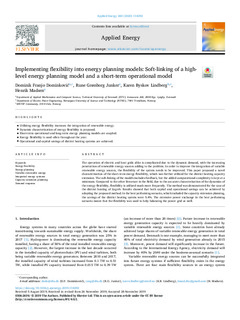Implementing flexibility into energy planning models : Soft-linking of a high- level energy planning model and a short-term operational model.
Journal article, Peer reviewed
Published version
Permanent lenke
http://hdl.handle.net/11250/2633299Utgivelsesdato
2020Metadata
Vis full innførselSamlinger
- Publikasjoner fra CRIStin - SINTEF AS [5801]
- SINTEF Community [2247]
Originalversjon
10.1016/j.apenergy.2019.114292Sammendrag
The operation of electric and heat grids alike is complicated due to the dynamic demand, with the increasing penetration of renewable energy sources adding to the problem. In order to improve the integration of variable renewable energy sources, the flexibility of the system needs to be improved. This paper proposed a novel characterization of the short-term energy flexibility, which was further utilized for the district heating capacity extension. The soft-linking of the models includes feedback, but the added computational complexity is kept at a minimum. Compared to the other literature in the field, due to the accurate characterization of the dynamics of the energy flexibility, flexibility is utilized much more frequently. The method was demonstrated for the case of the district heating of Zagreb. Results showed that both capital and operational savings can be achieved by adopting the proposed method. In the best performing scenario, which included the capacity extension planning, the savings of the district heating system were 5.4%. The extensive power exchange in the best performing scenario meant that the flexibility was used to help balancing the power grid as well.
Utgiver
ElsevierTidsskrift
Applied EnergyOpphavsrett
© 2019 The authorsBeslektede innførsler
Viser innførsler beslektet ved tittel, forfatter og emneord.
-
Energy measurements at Skarpnes zero energy homes in Southern Norway: Do the loads match up with the on-site energy production?
Sørensen, Åse Lekang; Imenes, Anne Gerd; Grynning, Steinar; Dokka, Tor Helge (Journal article; Peer reviewed, 2017)Five houses are designed as zero-energy homes in Skarpnes, Norway. The energy goal is to achieve net zero-energy balance on an annual basis. The houses have heat pumps and solar cells (PV). Energy use and delivered energy ... -
A coordinated control to improve energy performance for a building cluster with energy storage, EVs, and energy sharing
Huang, Pei; Zhang, Xingxing; Bales, Chris; Persson, Tomas (SINTEF Proceedings;5, Chapter; Peer reviewed; Conference object, 2020)Existing studies have developed some advanced controls for energy storage system charging/discharging in a building cluster (enabling PV power sharing among different buildings), which can effectively improve the aggregated ... -
Hospital Equipment and Energy Usage. Applied Research by the Low Energy Hospitals Project, Norway
Rohde, Tarald; Martinez, Robert (SINTEF Rapport;A26100 DP3-01, Research report, 2014)A26100 - Report No DP3-01

